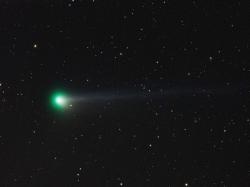On December 2, 1995, the SOHO (Solar and Heliospheric Observatory) spacecraft was launched aboard an Atlas/Centaur rocket from Cape Canaveral Air Station on a two-year mission to monitor the sun. Almost eleven years later, the SOHO spacecraft continues to faithfully record solar activity orbiting the Sun about 1.5-million kilometers inward from Earth. NASA and the European Space Agency operate the satellite jointly. Everyday, SOHO transmits pictures that are freely available for viewing on the Internet. These images inform scientists around the world about the Sun’s nature and behavior. Its images and data enable them to predict “space weather” events affecting our planet. Earlier in July of this year, someone discovered a new comet in a SOHO picture and now it’s gracing our evening skies as seen in this telescopic image.
The SWAN (Solar Wind ANisotropies) instrument is one of twelve onboard the SOHO (SOlar Heliospheric Observatory) satellite. It is a collaboration between the Finnish Meteorological Institute and Service d’Aeronomie and was constructed by the Finland’s Technical Research Centre. SWAN observes solar Lyman alpha radiation that is scattered by hydrogen atoms flowing into the solar system in all directions of the sky.
Comet Swan, designated C/2006 M4 (SWAN), is the eighth comet discovered with this instrument. Combined, the instruments on board SOHO have been the first to spot over 1,000 comets and that number grows each month! Comet Swan was discovered and reported separately by Rob Matson and Michael Mattiazzo earlier this year from an image that had been publicly posted in early July. Matson was able to trace the comet back to images as early as June 20 and by July 12, the first earth based picture had been produced with the 0.5-meter Uppsala Schmidt by Rob McNaught at Siding Spring, New South Wales, Australia.
Comet Swan has a hyperbolic trajectory that has untied it from the solar system- Comet Swan is now bound for the stars. In the past, some have speculated that, like an interstellar nomad, perhaps hyperbolic comets originate from another solar system, long wandering through interstellar space and, by lucky chance, are just passing through during our time on this planet. But, in reality, comets such as this have orbits that are just hyperbolic enough to dislodge their gravitational bond to the Sun. If we track the orbits of similar comets we find that a recent close pass to a major planet, such as Jupiter or one of the other gas giants, is enough to perturb their orbit into a hyperbolic orientation. So, most likely, Comet Swan was on a long period elliptical orbit around the Sun, but now it is being sling-shot out of the solar system. We are witness to its exit strategy. Appropriately, this is its swan song!
The first image featured with this discussion was produced by Italian astronomer Andrea Tamanti from his observatory located about 20 km from the center of Rome. Forty thiry-second images were combined to create this wonderful cometary portrait exposed on October 9, 2006. Spectacularly, the comet was passing near the much further way galaxy designated NGC 5005 in the northern constellation of Canes Venatici. Interestingly, NGC 5005 has been observed to have an X-Ray source at its center which indicated that it harbors a supermassive black hole. Andrea’s picture was taken through a custom built 12-inch Ritchey-Chrétien telescope at f/6 and a 3.5 mega-pixel astronomical camera.

Astrophoto: Comet Swan (C/2006 M4)
Image by Bernhard Hubl
Click to enlarge
On the following morning, October 10, 2006, Austrian astronomer Bernhard Hubl captured the magnificent image, above, from his observing location near Schlierbach. The comet was still in the constellation of Canes Venatici when this picture was taken. Bernhard’s thirty-three minute exposure is comprised of forty-three separate images that have been combined into a single picture. This picture was taken through a four-inch refractor at f/5.4 with a 2 mega-pixel astronomical camera.
Comet Swan has already made its pass around the sun and is barreling out of the solar system. Use this link to see a map of its path over the next few weeks. It will make its closest approach to the Earth near the end of this month. It will be millions of miles in the distance, however. Around Halloween, Comet SWAN can be seen passing near the Great Hercules Star Cluster, M13 and should be a real treat to observe through binoculars. By Thanksgiving, it will be located near the bright star Altair, however it will also be much dimmer as it will be well outside our family of planets on its journey to the edge of forever.
Do you have photos you’d like to share? Post them to the Universe Today astrophotography forum or email them, and we might feature one in Universe Today.
Written by R. Jay GaBany
